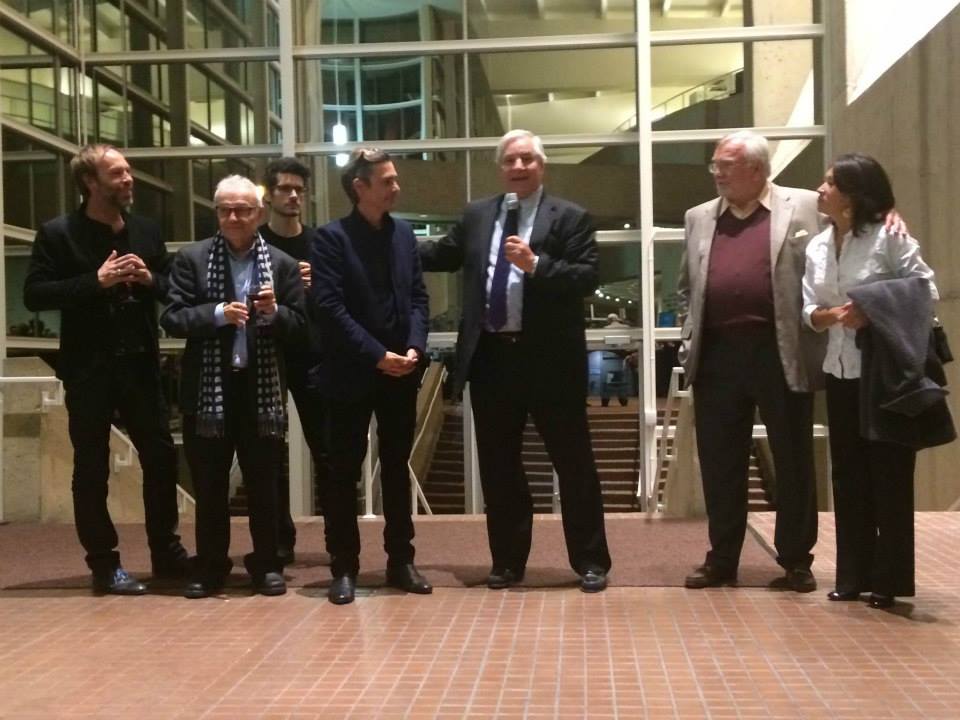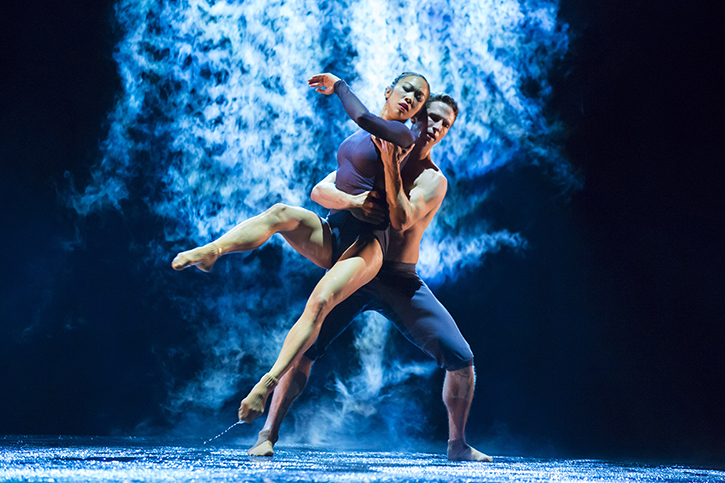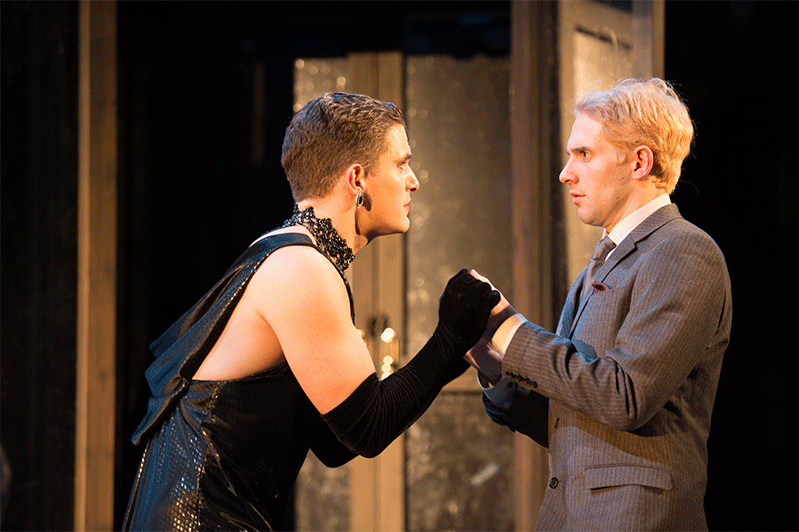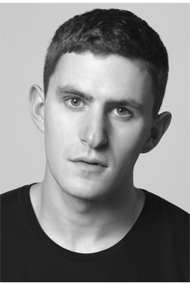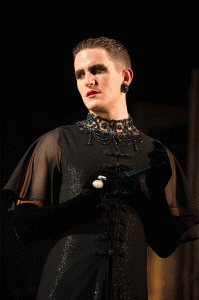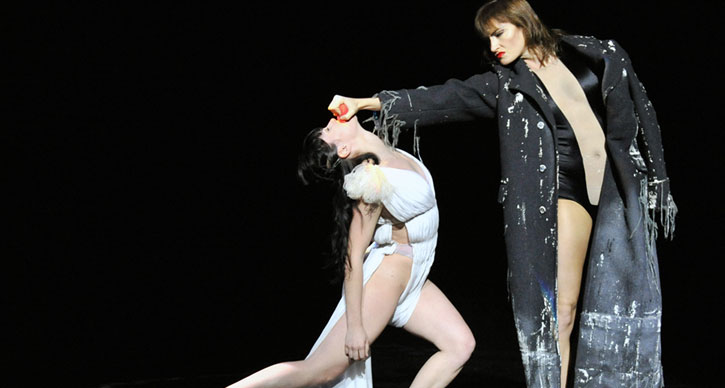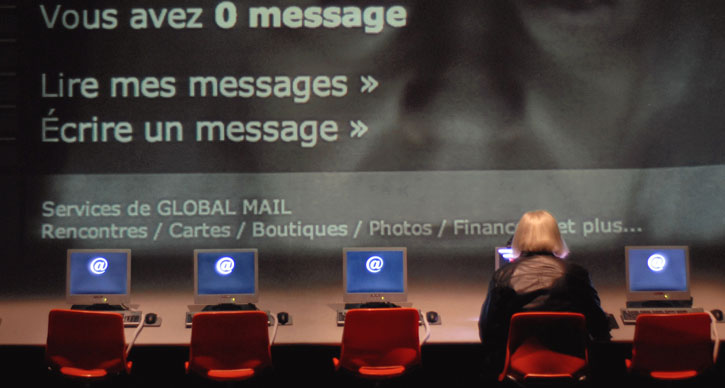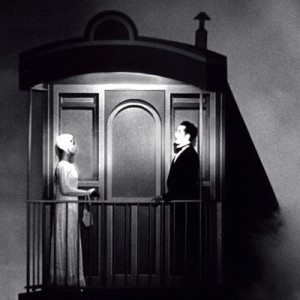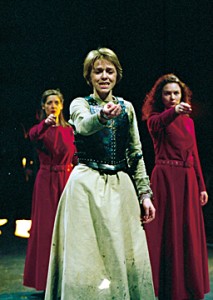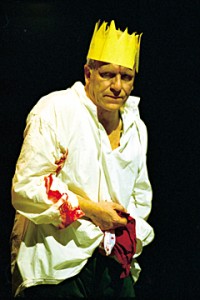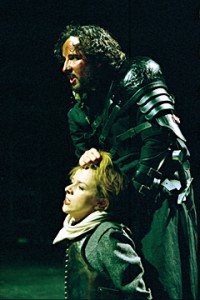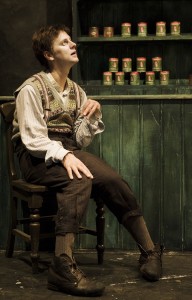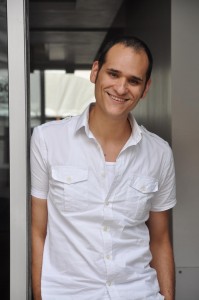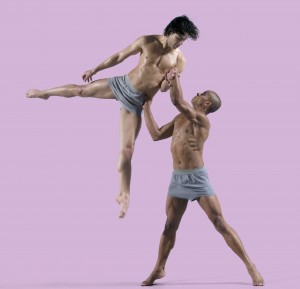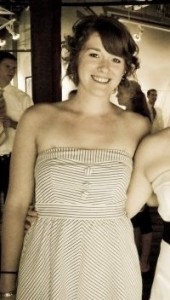Tune In Before Select Renegade Performances
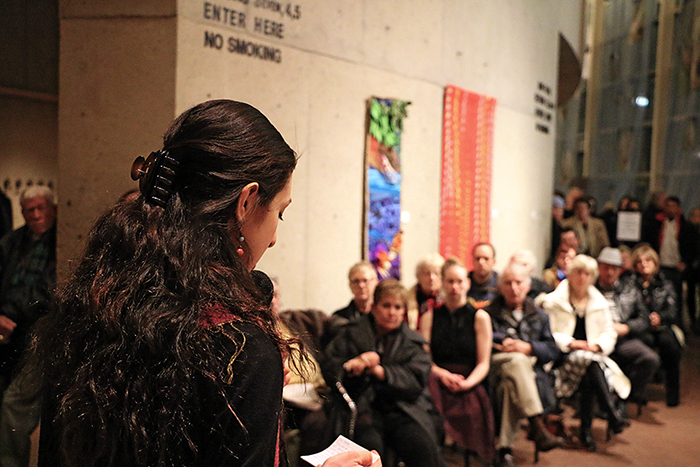 21st Century Artist Intern Hillary Kooistra gives a pre-show Tune In for Trisha Brown Dance Company’s performance February 21, 2015.
21st Century Artist Intern Hillary Kooistra gives a pre-show Tune In for Trisha Brown Dance Company’s performance February 21, 2015.
Tune In with UMS for a brief pre-performance talk before select Renegade series performances; the next Tune In is before Bill Frisell’s solo performance on 3/12. Just 15 minutes long, each Tune In offers interesting information and provocative questions for thinking about, listening to, and watching the performance. The Renegade series celebrates artistic innovation, experimentation, and discovery.
Kyle Abraham’s Childhood Road Trips
Listen to a funny outtake of Kyle talking about childhood road trips to Detroit & Jerry Curls. Check out his upcoming performances on March 13th and 14th: http://bit.ly/1iinyG7
At the opening night reception for Théâtre de la Ville
At the opening night reception for Théâtre de la Ville: UMS president Ken Fischer welcomed members of the creative team (on the left). Thanks to opening night supporters Frank Legacki and Alicia Torres (on the right).
Did you attend the performances? Don’t forget to share your thoughts.
Putting On “The Suit”
Editor’s note: Student volunteers at UMS often get the chance to take a deep dive into a performance or art form. In this essay, UMS Marketing intern Clare Brennan reflects on her experiences with “The Suit” directed by the legendary stage and film director Peter Brook. The performance will be at Ann Arbor’s Power Center on February 19-22, 2014.
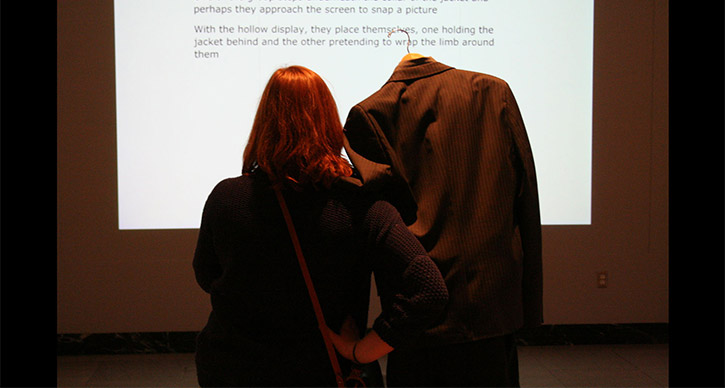
Photo: Clare Brennan and the UMS Student Committee take the suit around town as part of U-M Museum of Art’s “Love Art More” project. Photo by UMS Student Committee.
It’s not hard for me to remember one of the first books that really moved me. I was sitting in my living room, home alone on a bright August afternoon, finishing up some reading I’d been assigned for my last year of English in high school. I read the final paragraph, closed the back cover, and sat quietly for a while. I might’ve teared up a bit, if I’m being honest. The book was Alan Paton’s Cry, The Beloved Country, and it was then that I became infatuated with the stories and storytellers from South Africa.
As it turns out, my love for the French language and culture was growing right alongside this, as well as an absolute obsession with all things regarding Anglo-Saxon theater. Imagine, then, my elation when an opportunity to dive head first into The Suit fell into my lap. My nerdy heart fluttered. I accepted as nonchalantly as I could.
Apparently, my fixation with The Suit is not uncommon. Legendary theatrical director Peter Brook loved this story so much that, after directing the story once in French in 1999, he chose to return to it, this time in English. I had the chance to sit down with Michael Kondziolka, the Director of Programming here at UMS. He saw the debut of this production of The Suit last year in New York, and knew that Ann Arbor had to have the chance to see it. “It’s so painterly. A supreme colorist can use shadow and light and color and understands exactly how to use these different media to create a masterpiece. That’s what Peter Brook is doing. He knows how to use actors and written text and music and light and staging and movement and the audience, and how to craft all of that into something that is really powerful, really masterful.”
Of course, any discussion of South Africa must mention the recent passing of Nelson Mandela. The Suit is set on the cusp of Mandela’s most prominent years, and this energy of anticipation of what’s to come silently fills the stage. It provides an opportunity to see a South Africa without Mandela and his work, and as the world reflects on his incredible dedication to his country, taking a moment to step back and hear from those who came before him feels even more powerful.
With that context, The Suit might seem like a eulogy. Far from it. In talking with Michael, I got the chance to hear about what makes a Peter Brook piece tick. At the heart of each of his works is a dedication to simplicity. “This piece has a real lightness to it. And the lightness comes from the performance.” Over almost half- century of work, Brook has pared down his stages, from the intricate scenery of his staging of the Bard for the Royal Shakespeare Company to the openness of The Suit’s space. “It creates a sense of the fun of the performance. So you’ve got this really interesting visual experience. Your imagination is unlocked as an audience member, and that’s really entertaining and satisfying.” Brook trusts his audience, an honor not frequently given, and we’re free to reap the benefits.
While we covered many topics, my chat with Michael really focused on the music embedded in the show. From Schubert on the accordion to a poignantly placed introduction of Bach’s St. Matthew’s Passion (what Michael reverently referred to as “The Sistine Chapel of classical music”), it is evident that Brook knows exactly how to carefully weave music into his work. “Peter Brook is not only a master theater maker but he clearly is a student of culture, and the way in which he understands the meaning of these specific pieces of music and uses them to get his theatrical idea across.”
Studying up for The Suit has been a joy. Peter Brook knows how to tell a story, and his ability to transcend the barriers of the stage and approach each member of the audience with this incredible story of love and loss has no comparison. I’m so looking forward to seeing this show and finding what discoveries I still have left to make. The stage has a magical quality, and, in The Suit, it’s clear that Peter Brook knows it. “It’s pure poetry,” as Michael eloquently sums up. From what I can tell, I think he’s on to something .
Interested in learning more? Check out a brief infographic history of Peter Brook’s career or watch a storybook introduction to the performance.
Sources:
http://www.bouffesdunord.com/en/about-us/peter-brook
http://frenchculture.org/visual-and-performing-arts/events/us-premiere-suit-directed-peter-brook
A [brief] UMS History Presentation: Peter Brook
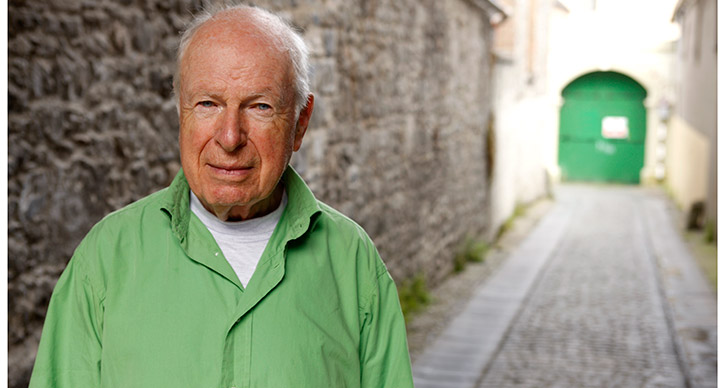
Photo: Peter Brook. Photo by Colm Hogan.
Director Peter Brook’s contributions to theater have spanned stage, film, and literary worlds. He directs The suit, performed by Théâtre des Bouffes du Nord at the Power Center in Ann Arbor February 19-22, 2014.
His legendary career has spanned decades and the world. Explore the timeline in this infographic:
Outside Looking In: Anne Grove on Hubbard Street Dance
Editor’s note: Hubbard Street Dance Chicago return to Ann Arbor on October 27, 2015.
This UMS 13-14 Season, Hubbard Street Dance Chicago will be bringing their first, evening-length piece to Ann Arbor’s Power Center September 27-28. To learn more about Hubbard Street behind the scenes, their new work, and Hubbard Street’s first resident choreographer, Alejandro Cerrudo, I sat down with UMS Artist Services Manager, Anne Grove, to talk about her experiences working as the company manager of Hubbard Street prior to coming to UMS.
This is the first time Hubbard Street has performed with UMS while you are working at UMS. What does it feel like to have Hubbard Street perform as part of the UMS season?
I’m really proud to see the company coming here, bringing Alejandro’s work, and I’m excited to see them! I don’t get to Chicago very often, so I’m really looking forward to having them here and to fulfill my old role a bit, working with them backstage.
What was your favorite or most memorable experience while working with Hubbard Street?
There were so many it’s hard to land on one! For one thing, it was amazing to see what ambassadors the Hubbard Street dancers are for the city of Chicago and for dance. I’ve had so many people come up to me and say after seeing a performance, “Oh I’ve never really liked dance” or “never been interested in it,” but because Hubbard offered such a variety within a single performance, it was a really great entry point into dance for a lot of people.
Personally, I really enjoyed the places I was able to travel to during my time as Company Manager. The events and receptions I attended, the people I was able to meet because I was a part of Hubbard Street that I never would have had any chance to otherwise. In Paris, a woman who happened to really like dance hosted a reception for us in her apartment where there were original Picasso sketches just lying on the floor…it was like being in a movie. Getting to travel with these talented artists and taking care of them; it was an incredible experience.
Did you always know you wanted to work with Hubbard Street?
No. I first saw Hubbard Street many years ago when I was still in Minneapolis and working with a couple different theater companies when Hubbard Street came through on a tour. I met Gail Kalver several years later, executive director of Hubbard at the time, at a booking conference. I had been with the company for several years at that point and had always wanted to travel overseas. My position at that time with the theater didn’t allow for much travel. I was always the point person who stayed home. When the company manager position became available at Hubbard, I pursued that.
How prepared were you for your new position with Hubbard Street Dance, coming from theater?
I really didn’t know much about dance at all. For the first couple of years with Hubbard, I made lots of mistakes. Things that are very important to theater artists are not necessarily important to dancers. Something so easy as, when you’re traveling overseas, ensuring the hotels have bathtubs because all the dancers like to soak after performing. For the first European tour, I had no idea that was a priority. There was a big learning curve, but the dancers really helped me along.
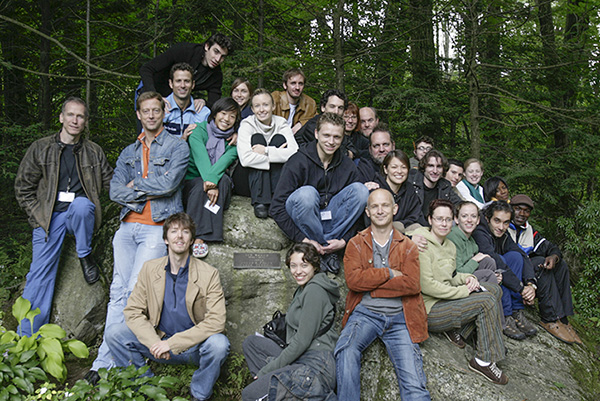
HSDC company photo on the Pillow Rock at Jacob’s Pillow Dance Festival, Becket, MA. Summer 2007. Alejandro (top) and Anne (bottom right, fourth person from the right)
Photo Credit: Cheryl Mann Photography
Hubbard Street is performing a piece created by choreographer Alejandro Cerrudo, entitled One Thousand Pieces, inspired by Marc Chagall’s America Windows. This work is the first evening-length piece they’ve ever performed. How do you see performing an evening-length piece as different from the vignettes they usually perform?
Well, as I alluded to before, the company is very much known for their repertory performances, so this is a really big step. With a repertory performance, you’re seeing work by lots of different choreographers, the pieces will be different, although you still try to program with something that brings the evening together or gives an arc to the performance as a whole. When you have a full-evening work, you’re still going to get some variety, but the performance will usually have just one central theme or look to it.
Has this been several years in the making?
Yes, they’ve been working towards this for a long time. I was with the company for 15 years and I think from my second or third year, they started talking about at some point doing a full evening work. There were many different choreographers discussed for doing a full evening work, and I’m so proud of the company for taking the big leap with Alejandro.
Not only is it the first evening-length work for Hubbard, but this was Alejandro’s first full evening work as well. Selecting such a young, up and coming choreographer really speaks to the core of what Hubbard Street is about: nurturing talented, young artists and helping them explore their talents.
Mr. Cerrudo was a dancer with the company before he became Hubbard’s first Resident Choreographer, yes?
Correct – he joined the company as a dancer in 2005 from NDT2 in Holland, although he is originally from Spain. NDT2 is legendary in its ability to identify and support the work of emerging professional choreographers. Alejandro participated in the choreographic workshops there and then at Hubbard, once he started dancing with us.
The first year Alejandro participated in the choreographic workshop, he did this amazing, beautiful duet, and Jim Vincent, artistic director at the time, asked him to create a full piece that grew out of that duet, which was later to become Lickity Split. And then, every year, Alejandro created a piece in that choreographic workshop which usually in one form or another became part of the Hubbard Street rep. In 2008, he became a choreographic fellow at Hubbard, and the following year, became Hubbard’s first resident choreographer. He’s done many works now for Hubbard as well as being hired by other companies to create for them.
Because he was a dancer with the company, he has gotten to know the Hubbard Street dancers in a way he does not know dancers from the other companies. The intimacy he was able to create in One Thousand Pieces because of that really comes across.
How do you think Chagall’s widely-known America Windows will function within the choreography of One Thousand Pieces?
Well, I’ve talked to Alejandro about it, and I was actually able to see the piece last fall when it was performed in Chicago, and I think it’s really important for people to know that the Windows were a point of inspiration.
He’s not recreating the windows or trying to tell a story. What influenced him was the idea of windows, and how windows and reflections off of glass distort, enhance, frame.
Also too he’s added some technical aspects that work with his voice and vision, embracing the technological age he grew up in. At one point in the piece, the dancers dance in water on stage in front of a mist curtain. You get the visual power of that, the smoothness of movement through the water, the sounds of that…it’s really quite unique and special.
Anything else audiences should look out for when seeing One Thousand Pieces?
I would encourage audience members to look for the duets, trios, and other small groupings of the company. I still harken back to the talent Alejandro displayed in choreographing the duet in his first workshop at Hubbard Street. He creates stunning duets, especially using his knowledge of the dancers on a personal level, having performed with them before, to his advantage. The group stuff is also very beautiful, but there’s something extraordinary about his small groupings.
I hope too that audiences will remain open-minded to a full evening, single-choreographer work from Hubbard Street. There’s music they’ll recognize, Philip Glass, and it’s a moment to enjoy the beauty of bodies, lighting, and music. Take away from it your own experience. Alejandro would say himself the piece doesn’t have to mean the same thing to him that it means to you. That’s not what it’s about. It’s about sharing that moment of beauty and letting it be whatever it is to you.
Thanks, Anne!
For more information on Hubbard Street performing at UMS this fall, see their artist page [here].
Propeller’s Ben Allen on playing women in Shakespeare
Editor’s Note: Propeller performs Twelfth Night and The Taming of the Shrew in Ann Arbor, February 20-23. The company was last in Ann Arbor in 2011 with Richard III. In this excerpt, actor Ben Allen talks about playing women in Shakespeare & more. Read the complete piece here.
Being part of Propeller, you often gets asked, “What’s it like playing a woman?” or “How do you approach playing a woman?” It seems to be a subject that many people are interested in, whether from an acting perspective, from a political perspective, or simply out of curiosity. In post-show discussions we are able to give brief answers to these questions but I thought it would be interesting to go into a bit more detail.
The idea of Propeller being an all male company is not something our artistic director Ed Hall deliberately set out to do. It all started with a production of Henry V at the Watermill Theatre in Newbury in the nineties, where Ed had the idea of telling the story through a chorus of twentieth century male soldiers – an idea that was revisited in our production of Henry last year. This initial production was a huge success and so Ed asked that company if they wanted to do another one. All actors who were in that first production were asked back to do the next production, something which Propeller continue to do to this day.
A lot of people I speak to about Propeller say, “Oh, so you’re doing it the traditional way” by this referring to the fact that in Shakespeare’s time, all the parts were played by men. While I can see what they mean, we’re not aiming to replicate that. From what we know the female parts would have been played by teenaged boys, whose voices had not yet broken, rather than fully grown men. By having men playing women we are making the audience complicit in the theatricality of the piece and the storytelling, rather than trying to make them believe what they are seeing is “real.” This high jump of the imagination makes for a highly rewarding experience, both for the audience and indeed the actors.
I am in my second year with Propeller now and have played two women over the four plays I have done: Perdita in The Winter’s Tale last year and Olivia in Twelfth Night this year. Olivia is a grieving countess, having recently lost her brother and father, yet arguably the highest status person in the play, who ruthlessly speaks her mind and commands attention, frequently demanding what she wants and putting down those around her in the blink of an eye. My motivations, vocal language and physical language are usually very different depending on who it is I am playing.
Olivia
If I’m to be specific then, I can share a bit of my ongoing experience creating the character of Olivia, since this is the part I am currently playing.
It is fair to say that my process of creating this character is roughly the same as with any character, be it male or female. I carried on to make four lists: the facts about my character; things she says about herself; things she says about other people, and things other people say about her. For example, we can safely assume that it is a fact that her brother and father have both recently died, we also know she is a woman, and that she is a countess. She says Malvolio is “sick of self love”, yet also says “I would not have him miscarry for the half of my dowry”. She is called “cruelty” by both Viola and Orsino, and Maria says Olivia will hang Feste for his absence from the house. These are just a few examples of clues within the text, which one ends up weaving together to create the basic foundations of the character.
One can also look at the form of Olivia’s words as they are on the page; she starts off the play speaking in prose, indicating perhaps a rational and emotionally disconnected state of mind. It is only towards the end of her first meeting with Viola, disguised as Cesario when she starts speaking in verse, which tells us something has changed within her! By looking closely at the text and mining out the clues within it, one can create a basic skeletal structure, which helps to plot the character’s journey through the play.
Something that playing a woman often requires is great change in physicality. It is a refreshing challenge for me, especially in a world where typecasting is becoming more and more prevalent. People often imagine it to be very difficult for men to inhabit more feminine qualities and vice versa, yet I think it mostly comes down to a question of the individual’s willingness to embrace the opposite sex within them. I am a firm believer that we are made up of both masculine and feminine aspects.
People ask if we spend time observing the way women move and so on, but I don’t really feel the need to do that as I’ve been doing it my entire life! I feel the key to really inhabiting this physicality is to root everything in the character’s inner life, history and desires and to try and be as specific as possible. Generalized “woman acting” would just be pretty crass I think, so one needs to be careful to think precisely about what kind of woman one is playing.
During the rehearsal process, I developed a detailed mental picture of how Olivia would look, move, speak and so on. I used plenty of specific personal references to build up this picture. This could be anything from women I have randomly encountered to friends or colleagues to characters from films. I made sure I had a rehearsal skirt to wear and I got my heels early in rehearsals, as wearing these things really do influence the way you move around – it’s much harder to go fast in heels! These kinds of abstract character references allow your imagination to take you off somewhere you can find all sorts of new things to try out.
All in all I find playing a woman extremely liberating
In terms of voice, I am not trying to exactly replicate a particular woman’s voice, something which I think would only act as a barrier between myself and the character, and in turn the audience and my character. Instead I aim to suggest a female voice by shifting the resonance higher up in my body. As a consequence of this the voice does become generally higher, but I remain connected to it and it still has the potential to drop down in tone and resonate from different areas. It is ultimately about finding a character voice that you can inhabit as fully as your own voice, once this happens you can go in any direction you want to go in and in turn make all sorts of discoveries.
All in all I find playing a woman extremely liberating. There is something so exciting about playing a character who is such a different entity to you. I count myself lucky to have had the opportunity to do this in such a wonderfully supportive company, especially in a world where many directors and casting directors understandably won’t cast you outside of your type because they can’t take the risk that you will be able to achieve the end result within the time frame of the project.
Many might ask, what is the validity of having men playing women?
As I write this I am aware of that fact that men playing women in the theatre has been the cause of much debate. Many might ask, what is the validity of having men playing women? Why not have women in this company? I personally cannot give formal answers to these questions but I hope that it is through such productions as ours, the recent all male productions of Twelfth Night and Richard III out of the Globe and the all female Julius Caesar at the Donmar, that audiences can grow to appreciate gender-blind casting. Surely by doing this we could potentially open up those hundreds of fantastic male parts in the classical repertoire for women to play.
In addition to this we need to encourage more female (and male) playwrights and directors to create work about women and for women. Hopefully by gaining more female work we can gain some kind of gender balance and I would much rather that than preventing more male-orientated work from existing or policing the arts and telling people what they can and cannot do. As a company we should be free as artists to put on the work we feel compelled to make, and as long as there are audiences willing to come and see us, I think we will be doing it for quite some time to come.
Ben Allen and Propeller perform Twelfth Night and The Taming of the Shrew at the Power Center in Ann Arbor February 20-23.
Once Upon a Time, in a land called The Power Center…
Photo: A scene in Snow White by Ballet Preljocaj.
Every great story rests upon a conflict of good and evil. As children, we might encounter lessons from this kind of conflict through fairy tales, morals and legends. We hear frightening tales with themes of greed, lust, disobedience, and consequences that most often resolve with the poetic justice of a happily-ever- after ending. These age-old tales are an imaginative vehicle for children to relate to the dark side of human nature and to understand the power of choice and free will.
Fairy tales are not just for children however. There’s been an increase in fairy-tale prime time TV, ABC’s Once Upon a Time and NBC’s Grimm, for example, as well as a surge in live-action movies, Mirror, Mirror and Snow White and the Huntsman, to name a couple. As adults, we still love these stories and we still relate to their symbols and themes.
UMS is presenting two artists whose work is influenced by fairy tales: Robert Lepage’s The Andersen Project and Snow White re-staged by Ballet Preljocaj.
The Andersen Project is inspired by the life of Hans Christian Andersen and highlights the fairy tale “The Dryad,” which is set in nineteenth century Paris and follows a young dryad who lives within chestnut tree on the outskirts of the city. The dryad longs to see the Paris she hears about in the stories of those who travel past her. When her wish is granted, she is moved the heart of the city, but her happiness there is short-lived. As Her true desire is not for the city, but for the freedom of movement, it turns out. When this wish is granted, it comes with a heavy cost. Read the whole story.
The Andersen Project also references Andersen’s “The Shadow.” In “The Shadow,” a man loses his own shadow. One night, it returns, knocking on his door and appearing almost human. The shadow grows richer and fatter, while the man grows poorer and weaker. In fact, the man is so ill that his shadow proposes a trip to a health resort, on the condition that the shadow can act as the master. At the resort, the shadow meets a princess, and later when the two are about to be marry, the shadow offers the man a position within the castle if he agrees to become his own shadow permanently. In the end, the secret swap is revealed and the consequences are deadly. Read the whole story.
We interviewed The Andersen Project’s lead actor Yves Jacques. Start at 3:16 mark to learn about how old ways of storytelling influenced director Robert Lepage’s construction of this project.
Snow White may be a more familiar story for most. Choreographer Angelin Preljocaj explains that his narrative ballet is not the myth or legend of Snow White, but the story of Snow White herself. He follows the Grimm brothers’ version version but adds small variations. The wicked stepmother is the central character of the tale. He examines her through her narcissistic determination not to give up on seduction and on her role as a woman, even if this means sacrificing her stepdaughter. Do you need a Snow White refresher? Read the whole story.
We are living during a climatic time in history and our choices can be felt globally thanks to technology. Is it any wonder that artists are turning to the world of fairy tales to highlight the fight between good and evil or the power of choice? Fairy tales allow us to reach into our imagination and to examine the good and evil that reside in all of us.
Why do you think fairy tales are on the rise? What are your favorite fairy tales?
5 Things to Know About The Andersen Project
1. Lepage initially created the role that is now performed by Yves Jacques, his “go-to” person for his one-man shows (Jacques was also the actor in Far Side of the Moon in 2005). The play is multi-layered and, like 08/09 Season’s Complicite, enjoyable on many levels – either at the top-level story or digging deeper into the meaning at its core.
2. Jacques plays all three main characters: Frederic, an albino rock lyricist from Montreal who heads to Paris to write the libretto for a children’s opera based on a Hans Christian Andersen story; Arnaud, the opera company’s fast-talking administrator whose personal life is unraveling due to his sexual obsessions; and Rashid, a Moroccan janitor who mops up after clients at a peep show that is located on the first floor of the same building that houses the apartment Frederic is subletting.
3. An example of the multi-layered structure: Lepage was commissioned to write a piece about Andersen to commemorate the 200th anniversary of his birth. His story is about a man who is commissioned to write a libretto for a children’s opera about Andersen. Two of Andersen’s fairy tales are woven into the script. The Dryad is about a tree nymph who sacrifices a long life in the woods for a single day in Paris – a parallel to the librettist, who is seeking artistic validation outside of his own country.
4. Those who have traveled in France will see many connections to what makes the French, well, French. There’s an opening monologue by the opera director, Arnaud, that is breathtaking in its scope and humor – nearly 2,000 words run together in a rambling yet coherent style that only the great storytellers like Spalding Gray or Garrison Keillor can accomplish. The monologue is performed with a strong accent, and every word is not intended to be understood — it’s meant to give a flavor of the character and his obsessive personality.
5. The piece is in both English and French (with supertitles). The constantly shifting projections and stagecraft make the technical aspects of the production at least as fascinating as the story itself.
Ultimately, The Andersen Project is really about an artist searching for validation and fame, unraveling relationships, and dealing with personal demons. The story itself is accessible in that The Andersen Project focuses on larger life issues that virtually everyone deals with at some point and can relate to in multiple ways.
See The Andersen Project March 15-17 at the Power Center.
Three Trucks, 28 Crew Members, 37 Performers: Einstein on the Beach Load-in at the Power Center
Photo: A moment on the train from Einstein on the Beach.
Inside the Power Center 14 days before the opening of Einstein on the Beach, it’s not immediately clear that this is, “hands down, the biggest show ever” to hit this auditorium, as UMS programming manager Mark Jacobson told me shortly before we entered the theater. But after an hour or so of listening to production manager Will Knapp talk about the challenges of mounting the giant opera here in Ann Arbor, I began to see what Jacobson meant.
Knapp met with around 30 UM stage management and design students on Friday in the first class of a semester-long course on stage production taught by Gary Decker of the UM School of Music, Theatre & Dance and other faculty. Collectively, the students brought a decent amount of expertise to the session, so there was lots of technical talk about things like trap doors, cyclorama lights, tracks, cues, headsets, and so on.
(“Is it hard to focus when you’re calling a show that’s five hours long?” one student wanted to know. “It kind of is,” Knapp said, and mentioned that, among other things, the opera’s three stage managers have to coordinate toilet breaks.)
Decker, who teaches theater production classes, told the students that scenery for the show arrived in Ann Arbor in two 53-foot trailers on the day after Christmas and had to be “shoehorned” into the Power Center—whose stage area is small as opera houses go—with “literally inches to spare.” It’s taken some 40 crew members, both local and touring, to load in Einstein’s sets, costumes, and props, and hang and focus lights. The lighting for the cyclorama alone is so complex crews need to devote an entire day to installing it.
The cast, who spent all of December rehearsing Einstein, arrived this Sunday, January 8. Final rehearsals start today, with mornings devoted to technical issues—setting light and sound levels, timing cues, perfecting scene shifts—and afternoons and evenings to a rigorous runthrough of the opera, in full makeup and costumes, under director Robert Wilson’s exacting eye.
An Auteur at Work
Knapp has worked with Wilson off and on for two decades and describes him as more of an auteur than a conventionally collaborative stage director. “It’s all him. Everybody is a helper. You really are an extension of his fingers.” An architect before he turned to theater, Wilson typically begins work on a production by sitting with an empty stage, Knapp said. “He treats it like an empty canvas. He creates pictures and then tries to animate them. He’s not trying to reinforce a narrative but to make interesting pictures for himself. This is the start of his process.”
Wilson makes sketches on copy paper, often in charcoal. It’s a rudimentary way of communicating with his production team “but also very specific,” Knapp went on, with particular attention to spatial rhythm and proportion. Eventually real drawings emerge, and then a model—components of which Knapp hauled from boxes on Friday and spread out on a table for the students to inspect: a meticulously built miniature clock, a train, a multi-story gray space machine.
Knapp also showed the students the 130-page “project book” he and others use to make sure each production of Einstein adheres to Wilson’s fastidious vision. The book includes directions on things like the angle with which a given character should gaze at the floor and the precise distance a character should maintain between her right arm and the back of the chair on which she’s sitting.
“Bob doesn’t collaborate,” Knapp said. “He is the author, the costume, light, set designer. The best way to work with someone like him is to listen really hard and do exactly what he says.”
The payoff should be apparent on January 20, when Einstein opens its three-preview-performance run in Ann Arbor, the kick-off to a 30-performance tour that will take the massive opera to France, Italy, London, the Netherlands, Toronto, New York, and possibly Hong Kong.
What might Wilson demand once he gets to the Power Center this week? The first thing Knapp expects this acknowledged wizard of light to do is to examine every single light in the theater—there are hundreds of them, plus a whopping 3,000 light bulbs spattered across the surface of the towering space machine. Knapp suspects Wilson will also ask for at least one drop to be repainted.
Says Decker, who’s seen a number of Wilson pieces, “I’m looking forward to Robert Wilson.” He adds with a grin, “But it’s going to be tough sledding to get to opening night.”
This Day in UMS History: Royal Shakespeare Company History Plays (March 10-18, 2001)
Ten years ago today, UMS audiences began a great experiment — the Royal Shakespeare Company presenting four Shakespeare History plays (Henry VI, parts i, ii, and iii, and Richard III) over the course of 27 hours with lunch and dinner breaks built in. The productions, directed by now-RSC artistic director Michael Boyd, marked the beginning of a long relationship between the University of Michigan and Ann Arbor with the RSC. Over the past decade, this partnership has included three major residencies, as well as workshopping new plays on the U-M campus. Each residency was accompanied by dozens of free educational events for students and the public-at-large.
Those who were present will no doubt fondly recall some of these images from the productions:
The three Henry VI plays were presented at 11 am, 2 pm, and 8 pm on a Saturday, with audiences returning on Sunday for the climactic production of Richard III. (There was also one mid-week cycle, which ran Tuesday, Wednesday [both matinee and evening], and Thursday.) Since that season, UMS’s theater programming has expanded significantly, with an annual commitment to presenting both live and high-definition broadcasts of international theater — including this season’s productions of Richard III and The Comedy of Errors by another British theater company, Propeller. Like the RSC, Propeller presents contemporary interpretations of Shakespeare and works with an ensemble cast; unlike the RSC, Propeller uses an all-male cast to present the Bard’s works, as would have been the case in Shakespeare’s day.
Richard III opens at the Power Center on Wednesday, March 30, and The Comedy of Errors opens the following evening. Tickets can be purchased at www.ums.org or by calling 734-764-2538.
A Dancer’s Life After Merce
Editor’s Note: Before he passed away, choreographer Merce Cunningham began planning for the future of his company without him. He decided that, upon his death, or at a suitable time thereafter, the Merce Cunningham Dance Company (MCDC) would embark on one final 2-year Legacy Tour and then dissolve. You can read more about his Legacy Plan here. Silas Riener, a dancer with MCDC, shares some reflections from his time with Merce and the company, and tells us a little bit about what life looks like for him after this final tour comes to a close.
 Ann Arbor marks the beginning of the 3rd week of this part of the tour, full of winter weather (Iowa, rural Pennsylvania, minus seven degrees at times…) and lots of good times. We have been performing lots of different rep, notably BIPED, which has only been seen once before on the Legacy Tour, and a few Soundance’s, which is always really nice for the company. Ann Arbor will see Split Sides and Squaregame, two of our more high energy pieces, which we have been looking forward to getting back into.
Ann Arbor marks the beginning of the 3rd week of this part of the tour, full of winter weather (Iowa, rural Pennsylvania, minus seven degrees at times…) and lots of good times. We have been performing lots of different rep, notably BIPED, which has only been seen once before on the Legacy Tour, and a few Soundance’s, which is always really nice for the company. Ann Arbor will see Split Sides and Squaregame, two of our more high energy pieces, which we have been looking forward to getting back into.
It has been interesting touring Merce’s work since he died. I feel like for many of us his presence was vital to our experience, and his input was crucial to our understanding of the material. Sometimes even his lack of input would be just as important; I learned so much from what Merce would say, or what he wouldn’t say. He was guiding our experiences, and in his absence, we have been forced to find governing principles for ourselves. Sometimes it seems easier than others; the vacuum persists.
Much thought and discussion has gone into planning the future once the company closes. For many of us dancers in the company, working for Merce was all we were ever interested in doing. It was a goal to be reached, and it certainly wasn’t easy. It’s strange to imagine other possible paths when the thing you have been trying for so long to get, you already have. It has made many of us reconsider our values and whether we are interested in continuing to dance or maybe more interested in doing something else.
For myself, I know that I still have a really strong interest in continuing to dance. I have been with MCDC for three and a half years now, and it has been a wonderful experience, but I have begun to feel the lack of my own creative voice. It has been hard since Merce died, that all the new work the company has taken in is revival. I can’t fully impart the sort of ecstatic paradigm shift that came when Merce was making a new piece, and I only really got to experience it once (Nearly Ninety). It was as if the steps were coming out of the air, and even if it was a familiar one, as it often was, say a triplet, it still felt special because you knew that no one had yet done a triplet THIS way. The revivals are wonderful, but it’s a different experience learning from video, or knowing that you are re-interpreting steps made for someone else.
It’s for this reason that I have begun to think about making work myself. Along with another dancer in the company, Rashaun Mitchell, I have begun creating dance projects, and we have put some showings together. It’s difficult to find rehearsal time inside the busy Cunningham touring schedule, but it’s been liberating at the same time. We are able to set our own schedule, and we are able to think of ourselves as makers with a real will to create something that maybe hasn’t been seen before.
Our first project together, a collaboration with poet Anne Carson ( a sometime Ann Arbor resident) was first shown last summer, both at Mount Tremper Arts Festival in New York, and at Boston’s ICA Co-LAB. Here in Ann Arbor, we’re taking some time to revamp a few sections of the dance, which takes Carson’s new book Nox as its subject. We’ll be showing a bit of it Thursday, February 24 at 3:10pm in Studio A of the U-M Dance Building if anyone is interested. An excerpt of the Boston performance can be seen below.
Hope you have enjoyed this bit of insight into the company life, and I hope you come to the show! Friday and Saturday, February 18-19 at the Power Center.
Volunteer Spotlight: UMS Ushers
It is so easy these days to attend a performance and never once interact with the presenter. If one purchases their tickets through the online system, has them mailed to their house and never has any questions then this patron of the arts could avoid all true human contact. Ushers are often the combo-breakers for our lack of interaction. Not only is it nearly impossible to pass through the lobby without a hello from an usher or staff member, ushers seat patrons, provide program books and give a warm smile to those that they come into contact with.
As I enter my fourth year as the front of house coordinator I cannot think of a better group of people to spend my days, nights and weekends with. Their dedication to UMS and its mission is heartwarming. To know that a group of more than 700 can unite for our cause is touching.
People usher for a variety of reasons; some come for the free performance, some for the sense of community, some volunteer as a resume booster, and some attend for the joy they feel when helping their fellow man (or woman) to wholly enjoy their experience at a UMS performance. While all of these are all excellent reasons to become part of this ever growing community, I find the most comfort in those that come for the self-fulfillment of helping another. Often our lives are bursting at the seams with responsibilities and tasks that take up most of our days – ushers are no different. They all lead busy lives and full time ushering is often a big commitment. The choral union series alone requires approximately 50 hours per season from each individual usher. These 50 hours come out of weeknights, weekends and all the other free time that could be spent doing something for themselves, but instead they selflessly devote their time to ensuring a wonderful experience for UMS patrons. These jobs aren’t always easy either, from disgruntled patrons, to distractions and mistakes on the staff’s end, ushers are responsible for making things right.
Jon and Carol Stinson have been ushering for over 10 years. Get to know them better with the video interview below!
Ushering is not all serious though. As a group, we love to have fun. From little bits of fun at performances to our end of the year usher party, we make sure to enjoy our time together. It really is a great experience, from the people you meet to the shows you see. Best of all UMS is always looking for more to volunteers! This year, orientation sessions will be held at the Modern Languages Building in Auditorium #3. If you are interested in becoming a part of the expanding team, come join us for some information and the opportunity to sign up to usher for the 2010-2011 season. All are welcome!
Returning Usher Orientation (ushered in the 09-10 season with UMS):
Thursday, September 2nd at 6:00pm
Tuesday, September 7th at 6:00pm
Thursday, September 9th at 8:00pm
Saturday, September 11th at 12:00noon
New Usher Orientation (did not usher in the 09-10 season with UMS):
Thursday, September 2nd at 7:00pm
Tuesday, September 7th at 7:00pm
Thursday, September 9th at 6:00pm
Saturday, September 11th at 10:00am
UMS Staff Picks: The Cripple of Inishmaan selected by Sara Billmann, Director of Marketing & Communications
SN: The multi-award winning Druid and Atlantic Theater co-production of Martin McDonagh’s The Cripple of Inishmaan has been described as “a break-your-heart, cruelly funny evening” – what kind of theatrical journey can audience members expect to experience when they see this production?
SB: I don’t want to spoil the story, but suffice it to say that it will be quite an emotional ride.
I’ve seen two of Martin McDonagh’s plays when they were produced in New York in the mid-late 1990s, and they are simply brilliant pieces, in part because of the way they force you to re-examine your own morals. He sets up these outrageous scenes that are absolutely hilarious, then delivers the knock-out punch that makes you realize you’ve been laughing at something that is, in fact, incredibly tragic. The June issue of <i>Opera News</i> put it perfectly: “As anyone who’s ever sat through a Martin McDonagh play can attest, sometimes the only response we can muster when confronted with the searing emotional or physical pain of others is a laugh.”
I read this play poolside while visiting my in-laws in San Antonio and found myself laughing out loud on any number of occasions. Let’s face it, there are many plays where you chuckle inwardly, but something that produces a spontaneous outburst while reading to yourself is extraordinary in its own sense. And based on every production I’ve seen of McDonagh’s work, the live production will far exceed what’s on the page.
So that we could all familiarize ourselves with the play, about a dozen members of the UMS staff did a “read-through” this summer. I hope that some audience members will be interested in doing the same — we’d be interested in putting together play-reading groups for others and loaning the scripts. It’s a great way to familiarize yourself with the dialects and turns of language that really bring the piece alive. And, of course, a great way to meet new people too.
SN: What are you most looking forward to about this UMS debut performance?
SB: It’s pretty simple, really – I just can’t wait to see what they do with the production to bring it alive. I have friends who saw this production when it was on Broadway a few years ago and raved about it. Having grown up in a small town, I recognize some of the quirky characters and look forward to seeing how they are realized on stage.
SN: What other events are on your “must see” list for the 10/11 season?
SB: Just about everything! As a trained classical musician, I’m particularly interested in the big orchestras and piano recitals. I was turned on to Denis Matsuev about two years ago by someone who had heard his recording in Gramophone magazine. His playing is really quite extraordinary. I also adore Schubert and am looking forward to the three Tákacs concerts, as well as the Scharoun Ensemble performance of the Schubert Octet. I’m also looking forward to Grupo Corpo – what a great company! I could go on and on. The beauty of being the marketing director for UMS is that I start to research all of the artists we’re presenting long before we announce the season, and I always get turned on to things I never would have thought I’d enjoy…which ultimately means that the entire season becomes a “must see” for me.
SN: What do you enjoy doing outside of work?
SB: I have two kids – Elisabeth is 8 and going into 4th grade, and Harry is 6 and going into 1st grade – who keep me plenty busy. I was about to respond that I do laundry outside of work, until I saw the word “enjoy” in the question. Elisabeth loves to play baseball, so I think I’ve spent the better part of July attending her games and taking her to see the Tigers when time permits. I’m also hopelessly addicted to The New Yorker and steal moments here and there to try to stay caught up. Other hobbies include wine tasting and walking the dog – we acquired a boxer/pointer mix from the Humane Society three months ago, and I’ve become the family’s designated dog walker, which fills up a shocking amount of time each day.
SN: What have you been listening to on your iPod?
SB: Ha! The day I get to listen to my iPod will be a great day indeed. Lately my kids have been torturing me, making me listen to “Stayin’ Alive” and 1980s dance tunes (oh, to return to the days when my daughter would watch “The Barber of Seville” by choice…). But when I can wrestle it away from them, I mostly listen to Schubert lieder, Maria Joao Pires performing Schubert and Chopin, Denis Matsuev playing Rachmaninoff, and Mahler, though truth be told, the iPod doesn’t do Mahler justice. Murray Perahia‘s recital in 2000 of the Bach/Busoni Chorale Preludes and the Goldberg Variations will always rank among my top UMS performances, and I often bring back that memory with the recording “Songs Without Words” released around the same time. Angelika Kirchschlager and Fritz Wunderlich are among my favorite singers, though I will confess that I also enjoy Pink Martini in my less serious moments. And I recently loaded on a CD by a wonderful Iranian group called Ghazal.
UMS Staff Picks: Laurie Anderson’s Delusion selected by Jim Leija, Public Relations Manager
SN: Laurie Anderson’s daring and thought-provoking use of technology in her pieces has earned her worldwide recognition – just what kind of an artist is she and how can audience members expect to see her multi-media approach come to life in Delusion?
JL: As a student and practitioner of performance art, I’ve studied and admired the legendary Laurie Anderson for a long time. Anderson is an artistic pioneer, blending visual imagery, text, and electronic music (even inventing several unique electronic instruments) to create theatrical events that twist our perception of reality. A lot of her text reminds me of that of the late monologist Spalding Gray (who was a collaborator of Anderson’s): slightly offbeat and neurotic, strangely funny, and astutely observant. When you’re watching Laurie Anderson perform, you almost feel like you’re in a dream – quirky, bizarre, trancelike, too real, or not real enough. Anderson has an incredible talent for taking bits and pieces of our hyper-commercial, hyper-politicized society and spinning them into moments of hyper-realistic cyber-techno poetry that challenge authority, bend reality, and demand that we see the world differently. Audiences can expect to be surprised and challenged by the way Anderson transforms herself through what she’s called “audio drag”: sometimes she’s the cool, calm, collected self-help guru, sometimes she’s the evil robot of our worst sci-fi futuristic nightmares, and other times she’s a domineering patriarch. Never one to mince words, Anderson has recently explored highly charged issues like homelessness, terrorism, the war in Iraq, the collapse of Wall Street, and the oil spill in the gulf. I am most excited by contemporary artists like Anderson who are willing to tackle tough issues in ways that might leave audiences feeling a little uncomfortable and a little uncertain about how they should respond. I like to feel challenged by performance and to be shaken out of everyday complacency. I expect that in Delusion we’ll experience many of the Laurie Anderson “ingredients” that I’ve mentioned, and we’ll be transported into Anderson’s unusual, but compelling universe.
SN: Have you seen a performance by Laurie Anderson before?
JL: I’ve actually never seen Laurie Anderson perform live! I’ve only experienced her work through video and audio recordings. I’m looking forward to finally seeing her perform in-the-flesh after admiring and studying her work for so long.
SN: What other events are on your “must see” list for the 10/11 season?
JL: When I was working on my MFA in Art & Design, I experimented with sound installation and the ways in which an artist can use sound to change how people experience a particular place. I’m looking forward to Susurrus to see how David Leddy uses sound and narrative to recreate the Matthaei Botanical Gardens in a new and exciting way. I just have a feeling that Susurrus is going to be really magical.
Carolina Chocolate Drops is an absolute must. I saw the group when they first played at The Ark three years ago, and I still think back to that concert as one of the best I’ve seen in recent years. The CCD is so masterful at blending amazing bluegrass musicianship with educational tidbits about Black string music. I learned a lot, and I slapped my knee to the beat a lot, and I plan to do the same when they take the stage at the Michigan Theater.
SN: What do you enjoy doing outside of work?
JL: For me, the summer is all about vegetable gardening, going to the Ann Arbor Farmer’s Market, and cooking up a storm. I grow everything from tomatoes to eggplant to kale and herbs in my backyard garden, and my partner and I get a farm share from Tantre Farm in Chelsea. We love to see just how “local” we can be, especially during the summer months when so much amazing, fresh food is available in Ann Arbor.
SN: What have you been listening to on your iPod?
JL: The performance artist in me is listening to a lot of Lady Gaga. The chef in me is catching up on Splendid Table podcasts. The hipster in me is jamming to OK Go (can you believe that video with the Rube Goldberg machine?!).
Have you seen a live performance by Laurie Anderson before? We’d love to hear about your favorite performance artist!
UMS Staff Picks: Grupo Corpo selected by Rachelle Lesko, Development Administrative Assistant
SN: Grupo Corpo’s work has been described as “searing sensuality elegantly under control” (Le Monde, Paris)—what specific style(s) of dance can audience members expect to see at this performance?
RL: From the numerous video clips I have seen, they are masters of blending many different styles of dance like ballet, modern dance, and Brazilian dance. Each of these dance styles is known for different focal elements such as grace, fluidity, dynamic energy, and sensuality, and the way that Grupo Corpo manages to merge and transition between these different stylistic elements is incredible. The piece Imã, which they are performing in Ann Arbor, showcases a tremendous sense of fluidity and strength between the dancers. Throughout the course of the piece they seamlessly transition from modern dance and Afro-Brazilian visual and musical influences to lyrical ballet and lively, hip-shaking samba moves. I can’t wait to see it in its entirety.
SN: Have you seen a performance by Grupo Corpo before?
RL: I have not seen Grupo Corpo perform in person before, but I have attended many other UMS dance performances. A few that I particularly enjoyed over the years were Rubberbandance Group, Hubbard Street Dance Chicago, and the Trinity Irish Dancers — each of which embodies, in different ways, the energy, athleticism, and passion that can be found in Grupo Corpo. I love attending dance performances because of the sheer emotion and physicality present on the stage in front of you, which I find thrilling. I never get bored! There is always something to capture my attention, whether it’s the amazing technique of an individual or the interactions and broader picture of the group as a whole. I find dance companies that make a point to interweave different dance styles, like Grupo Corpo, especially enjoyable to watch because they throw in a little bit of the familiar for everyone, but then take you by surprise and bring it to a completely new and creative level.
SN: What are you most looking forward to about this performance?
RL: I think I am most looking forward to experiencing the blend of their particular dance styles, especially the incorporation of Brazilian samba and Afro-Brazilian roots. Latin dance (and music) is incredibly dynamic, infectious, and just plain fun! I can’t wait to see how Grupo Corpo brings that flavor to life on the stage AND to the audience.
SN: What other events are on your “must see” list for the 10/11 season?
RL: Wow. That’s a hard question! First of all, I want to say that I’m really excited about this season in general because there are so many artists coming that I personally am not familiar with and/or have never seen perform before, so I’m really looking forward to a year of new experiences. However, I do have a few that are definitely on my radar, like Rosanne Cash, Carolina Chocolate Drops, Rafal Blechacz, Tetzlaff Quartet, Mariachi Vargas de Tecalitlán… I’ll stop there, but I could go on! I think this season’s global focus on the Americas is going to be very exciting and I’m looking forward to attending many of those concerts.
SN: What do you enjoy doing outside of work?
RL: In my free time I enjoy playing the trumpet, both casually and in a local concert band, and spending time with friends and family. I also enjoy running and have recently started to participate in longer distance road races, which I find much more fun and exciting than the training part!
SN: What have you been listening to on your iPod?
RL: Well, a lot of what I’ve been listening to lately has been my running music so it’s a lot of upbeat 80’s rock music: Def Leppard, AC/DC, Journey, R.E.M, Madonna, etc., as well as some Natalie Merchant, Tori Amos, and Norah Jones to relax.
What is the most memorable dance event you’ve ever been to?


